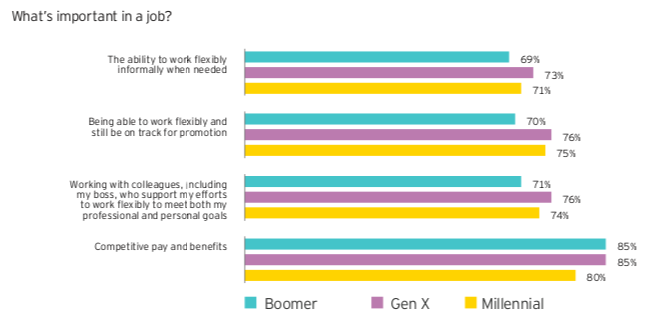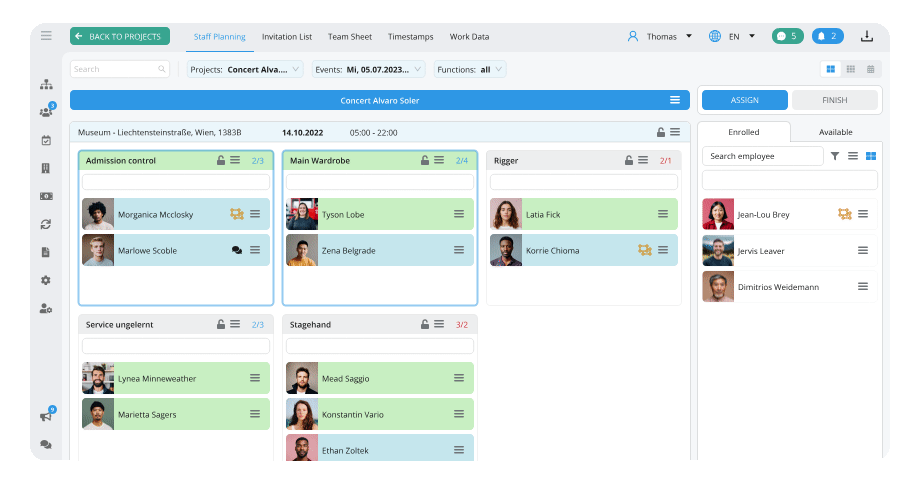Digitalisation has brought about a raft of new working models and confusing terminology. We restore order to this chaos and address a common misconception when it comes to the modern world of work.
The workplace is changing, not least due to new technological advances. For example, mobile work was largely unknown only ten years ago. Today, there are entire companies, such as technology provider Zapier, who use 100% remote workers.
We take a look at…
- the definition of flexible work and modern working environments and where the difference between the two lies.
- different flexible working models such as temp work, telecommuting and part-time work.
- their respective advantages and disadvantages.
- Useful facts for employers who are considering flexible working models.
We answer key questions and clarify one of the biggest misconceptions about today's working world!
What is Flexible Work and What Are Modern Work Environments? - a Definition
'Flexible work' or 'flexwork' functions as an umbrella term for all types of employment which deviate from the traditional working models. They fall into the following categories:
- Flexible work time models create room to manoeuvre in terms of working time, including flexitime and part-time work.
- On-the-go work, work from home, and telecommuting provide more freedoms when it comes to choosing a place of work.
- Flexible contract models give employers more flexibility in case of fluctuating workloads (such as seasonal or project-based fluctuations). Temp work and optional working time are good examples of this.
Some of the flexwork models combine more than one solution.
New work or new working model is an even more abstract term. It simply describes any modern working model for the global and digital age in today's society. This means that new working models are strongly dependent on the opportunities brought about by digitalisation as well as on what is required of employees, as defined by younger generations (such as the infamous Millennials) and societal values (such as the desire to spend more time with family).
The biggest misconception about new working models
Many employers think that it would be more important for staff members to work flexibly than to earn more money. However, this is a misconception.
A global survey conducted by EY found that for around 85% of employees, competitive pay is the most important factor for choosing a job, while being supported in their efforts to work more flexibly to meet personal and professional goals, and the ability to work flexibly while still being on track for a promotion are in second and third place respectively.

Source: EY Global Study on Work Life Balance
So what does this mean for employers? As they face strong competition when it comes to finding the best candidate for a job, they cannot get around offering flexible working models. Nevertheless, such offers cannot be reflected in lower remuneration. Promising a new working model is not a substitute for fair payment.
It is even more important to pay employees well when they are working in a flexwork model which is primarily beneficial for employers. Temp jobs are a good example for this. When a company enables more flexibility while also offering less job security, this should be appropriately remunerated as well.
Types of Flexible Working Models – a Glossary
Flexible Working Time
Flexitime
Probably the most widespread and well-known form of flexible working time model. A whopping 80% of UK companies offer at least some type of flexible arrangement for some of their staff. The idea is simple: instead of everyone sitting at their desk at 8 am and shutting the office at 5 pm, staff start work and leave at different times.

Source: CIPD Working in the UK
Often, employers require core working times, such as between 10 am and 4 pm, during which all staff should work. Despite flexible time schedules, the contractually-specified weekly working time has to be observed.
|
Advantages |
Disadvantages |
|
|
Part-Time (with a Focus on Part-Time Leadership) and Job Sharing
Many people associate part-time working models with mothers who are looking for a way back into work after maternity leave. Phrases such as 'trapped in part-time work' show the negative perceptions of such work in society. And after all, it is those with low incomes who are most negatively affected by part-time jobs. As they are not technically unemployed, they are not entitled to state benefits, while their pension contributions are limited and they hardly earn enough to live on.
The situation is somewhat different for higher income groups, such as those working in leadership positions and academics. In such positions, part-time work often does not mean that they are only there 50% of the time, but rather 75-80% of the time, which is much closer to working full-time. Job sharing means that two or more part-timers share one position. Usually, they work 60-75% of the time compared to a full-time job to ensure smooth handovers and arrangements.
These part-time models for leadership positions and job sharing are worthwhile for companies if the employees hired in these positions bring special knowledge to the company, as they are generally more expensive for employers than hiring someone in a full-time position.
However, these models have a signalling effect and can have a significant impact on a company's culture, meaning that they will become even more widespread in the future – and they are not just for working mums but also for their partners, or for people without children who prioritise a good work life balance.
|
Advantages |
Disadvantages |
|
|
Functional and Optional Working Time
Functional and optional working time gives more responsibility to employees than flexitime, but not quite as much as trust-based working hours. For functional working time, it is assumed that there are certain times during which a certain number of employees have to be present in a department to ensure functionality. However these members of staff decide to organise themselves is up to them.
Optional working time offers similar flexibility. For this model, employees note down their preferred working times, and they are taken into account when staff scheduling takes place. This model works best if staff members who work together have different preferences (such as those who like to take on nightshifts and those who prefer coming to work very early and leaving in the afternoon). As a working model, this is particularly popular in the service industry, for example in bakeries or for plumbers, and it only works if employees are happy to forego working when business is slow.
|
Advantages |
Disadvantages |
|
|
Trust-Based Working Hours
This is the alternative to jobs in which time tracking is unnecessary and/or difficult to implement. It is also suitable for workplaces who want to reduce administrative expenditure and offer their staff maximum flexibility.
For this model, employees are given a high level of responsibility for their work time and have to manage their time and working method themselves in order to ensure that they fulfil their tasks according to deadlines and that they achieve certain targets.
|
Advantages |
Disadvantages |
|
|
Flexible Place of Work
Home Office/Work from Home
Working from home is just that. It enables employees to skip the commute and work from the comfort of their own home once in a while. Usually, this has to be arranged and approved by a manager or supervisor, however, some companies leave it completely up to their employees where they want to work.
Mobile Work/Telecommuting
Mobile work, also known as telecommuting, means that there is no fixed place of work in the first place. Employees have their 'office' set up in their own home and do all their work remotely. With the right processes and technologies, companies can significantly reduce costs, while also being able to choose from a much wider group of people when hiring talent – after all, their are no geographical requirements for their choice of candidate.
Many companies offer certain positions which are not location-based (for example customer support agents), while other jobs within the same company are location-based by necessity (such as sales manager positions).
|
Advantages |
Disadvantages |
|
|
More Flexibility for Employers
Temping/Agency Work
When it comes to temp work, companies do not employ workers directly, but rather contract a temp agency which supplies them with suitable staff.
This enables companies to better cope with fluctuations by filling gaps with agency workers. For the workers, on the other hand, this offers the opportunity to get insights into many different companies. A survey conducted by REC found that 39% of people in the UK have worked as a temporary worker before.
To avoid unfair treatment and wage competition, most countries have implemented legislation outlining how much time a worker can spend in a given job before they are entitled to the same treatment and compensation as comparable co-workers. In the UK, this is set at 12 weeks. You can find further information on UK legislation regarding temp staff here.
|
Advantages |
Disadvantages |
|
|
Freelancer
Hiring freelancers provides the highest possible level of flexibility for both sides. They can be used for certain projects, or called upon for certain tasks again and again. The greatest advantage is that freelancers are only paid for their work. There are no non-wage labour costs, they are not entitled to anything other than this remuneration.
However, the downside is that freelancers might decide overnight that they no longer wish to work for a certain company. This can be avoided by contractually stipulating the arrangement between freelancer and company.
|
Advantages |
Disadvantages |
|
|
Conclusion
There is a wide variety of options when it comes to flexible work models. To successfully use new models, you should seek legal advice on a case by case basis. Whether you would like to appeal to new talent, plan more efficiently or speed up growth – a healthy mix of flexible workers and modern working conditions (such as free choice of place of work and working time) provide great potential.
To keep track of your flexible workforce and ensure that you comply with legal time tracking obligations, find out more about the staff planning software - Staffcloud!









